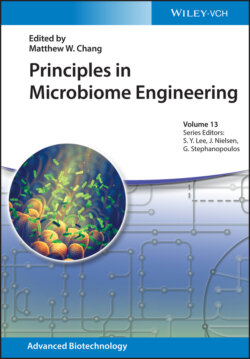Читать книгу Principles in Microbiome Engineering - Группа авторов - Страница 2
Table of Contents
Оглавление1 Cover
2 Title Page
3 Copyright
4 Preface
5 1 Diet‐Based Microbiome Modulation: You are What You Eat 1.1 Introduction 1.2 Dietary Lifestyle Variation Affecting Host Microbiome 1.3 Dietary Modulation of Microbiome for Disease Treatment 1.4 Challenges and Opportunities 1.5 Concluding Remarks Acknowledgments References Notes
6 2 Microbiome Engineering for Metabolic Disorders 2.1 Introduction 2.2 Microbiome Engineering for Diabetes and Obesity 2.3 Microbiome Engineering to Modulate Gut–Liver Axis 2.4 Microbiome Engineering for Cardiovascular Diseases 2.5 Microbiome Engineering to Modulate Gut–Brain Axis 2.6 Clinical Translation of Live Biotherapeutic Products 2.7 Conclusion and Future Directions References
7 3 Repurposing Microbes for Therapeutic Applications in Humans 3.1 Introduction 3.2 A Brief Overview of Microbiota and Human Health 3.3 Systems Biology Approach to Analyze the Gut Microbiota Functions 3.4 Engineering Microbiome to Treat Diseases 3.5 Perspectives and Conclusion References
8 4 Modulating Residence Time and Biogeography of Engineered Probiotics 4.1 Introduction 4.2 Adhesion Mechanisms 4.3 Adhesion Modulation 4.4 Functional Encapsulations and Biofilms that Modify Gastrointestinal Dynamics of Probiotics 4.5 Metabolic Engineering to Modulate Gut Adaptation 4.6 Conclusions References Note
9 5 Microbiome Engineering for Next‐Generation Precision Agriculture 5.1 Background 5.2 Systems Approach to Microbiome Engineering 5.3 Synthetic Biology for Genome and Genetic Engineering of Phytobiomes 5.4 Conclusion and Future Perspectives Acknowledgments References
10 6 Biological Sensors for Microbiome Diagnostics 6.1 Introduction 6.2 Diagnosing the Microbiome 6.3 Types of Biosensors 6.4 Testing and Utilizing Engineered Biosensors 6.5 Conclusions/Summary Acknowledgments References
11 7 Principles, Tools, and Applications of Synthetic Consortia Toward Microbiome Engineering 7.1 Introduction 7.2 Advantages of Labor Division via Synthetic Microbial Consortia 7.3 Tools for Engineering Synthetic Consortia 7.4 Engineering Syntrophy 7.5 Engineering Population Control 7.6 Synthetic Microbial Consortia and the Human Microbiome 7.7 Conclusions and Future Perspectives References
12 8 Fecal Microbiota Transplantation for Microbiome Modulation: A Clinical View 8.1 Introduction 8.2 Fecal Microbiota Transplantation (FMT) 8.3 Clinical Application of Fecal Microbiota Therapy 8.4 FMT – Novel Indications 8.5 Conclusion References
13 9 Maternal Microbiota as a Therapeutic Target 9.1 Introduction 9.2 Human Maternal Microbiota 9.3 Maternal Microbiota and Health 9.4 Human Milk Microbiota and Infant Health 9.5 Drug Treatment, Unhealthy Conditions, and Microbiome 9.6 Probiotic and Prebiotic Therapies as Modulators of Microbiome References
14 10 Transcription Factor‐Based Biosensors and Their Application in Microbiome Engineering Summary 10.1 Design: TF‐Based Biosensors 10.2 Build: TF‐Based Biosensors 10.3 Test: TF‐Based Biosensors Application in Microbiome 10.4 Learn: Strategies for TF‐Based Biosensor Improvement 10.5 Conclusions Acknowledgments References Note
15 Index
16 Wiley End User License Agreement
